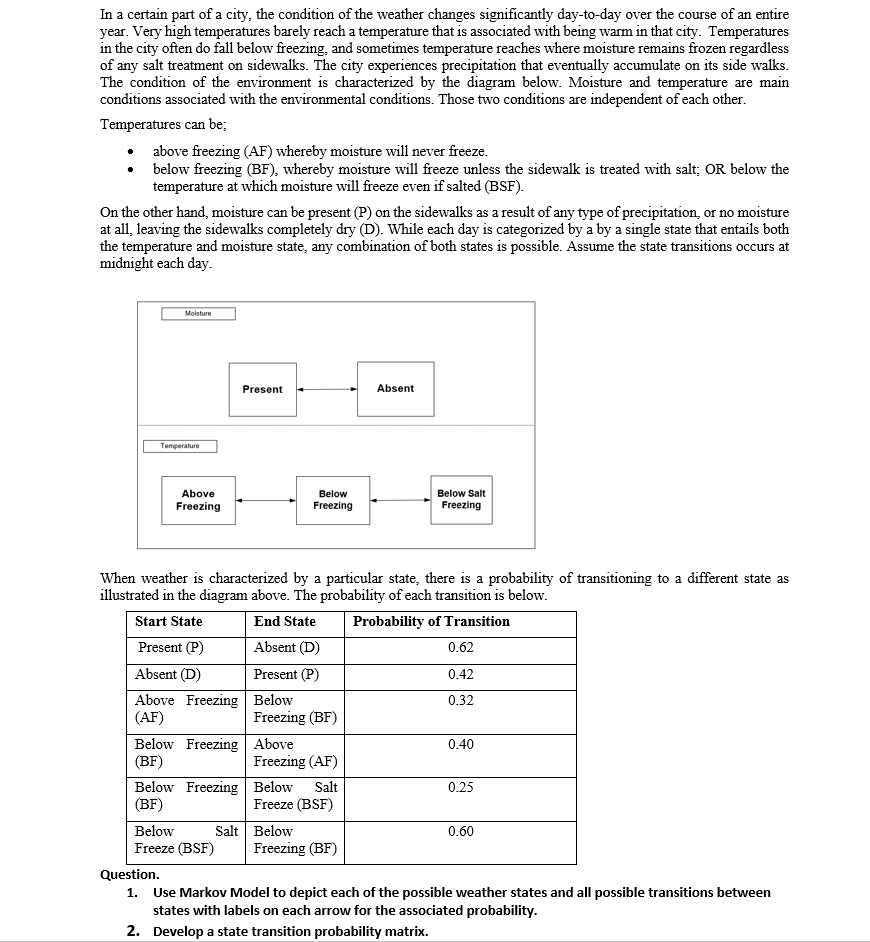
In a certain part of a city, the condition of the weather changes significantly day-to-day over the course of an entire year. Very high temperatures barely reach a temperature that is associated with being warm in that city. Temperatures in the city often do fall below freezing, and sometimes temperature reaches where moisture remains frozen regardless of any salt treatment on sidewalks. The city experiences precipitation that eventually accumulate on its side walks. The condition of the environment is characterized by the diagram below. Moisture and temperature are main conditions associated with the environmental conditions. Those two conditions are independent of each other. Temperatures can be above freezing (AF) whereby moisture will never freeze. below freezing (BF), whereby moisture will freeze unless the sidewalk is treated with salt: OR below the temperature at which moisture will freeze even if salted (BSF). On the other hand, moisture can be present (P) on the sidewalks as a result of any type of precipitation, or no moisture at all, leaving the sidewalks completely dry (D). While each day is categorized by a by a single state that entails both the temperature and moisture state, any combination of both states is possible. Assume the state transitions occurs at midnight each day. Moisture Present Absent Temperature Above Freezing Below Freezing Below Salt Freezing When weather is characterized by a particular state, there is a probability of transitioning to a different state as illustrated in the diagram above. The probability of each transition is below. Start State End State Probability of Transition Present (P) Absent (D) 0.62 Absent (D) Present (P) 0.42 Above Freezing Below 0.32 (AF) Freezing (BF) Below Freezing Above 0.40 (BF) Freezing (AF) Below Freezing Below Salt 0.25 (BF) Freeze (BSF) Below Salt Below 0.60 Freeze (BSF) Freezing (BF) Question. 1. Use Markov Model to depict each of the possible weather states and all possible transitions between states with labels on each arrow for the associated probability. 2. Develop a state transition probability matrix. In a certain part of a city, the condition of the weather changes significantly day-to-day over the course of an entire year. Very high temperatures barely reach a temperature that is associated with being warm in that city. Temperatures in the city often do fall below freezing, and sometimes temperature reaches where moisture remains frozen regardless of any salt treatment on sidewalks. The city experiences precipitation that eventually accumulate on its side walks. The condition of the environment is characterized by the diagram below. Moisture and temperature are main conditions associated with the environmental conditions. Those two conditions are independent of each other. Temperatures can be above freezing (AF) whereby moisture will never freeze. below freezing (BF), whereby moisture will freeze unless the sidewalk is treated with salt: OR below the temperature at which moisture will freeze even if salted (BSF). On the other hand, moisture can be present (P) on the sidewalks as a result of any type of precipitation, or no moisture at all, leaving the sidewalks completely dry (D). While each day is categorized by a by a single state that entails both the temperature and moisture state, any combination of both states is possible. Assume the state transitions occurs at midnight each day. Moisture Present Absent Temperature Above Freezing Below Freezing Below Salt Freezing When weather is characterized by a particular state, there is a probability of transitioning to a different state as illustrated in the diagram above. The probability of each transition is below. Start State End State Probability of Transition Present (P) Absent (D) 0.62 Absent (D) Present (P) 0.42 Above Freezing Below 0.32 (AF) Freezing (BF) Below Freezing Above 0.40 (BF) Freezing (AF) Below Freezing Below Salt 0.25 (BF) Freeze (BSF) Below Salt Below 0.60 Freeze (BSF) Freezing (BF) Question. 1. Use Markov Model to depict each of the possible weather states and all possible transitions between states with labels on each arrow for the associated probability. 2. Develop a state transition probability matrix







